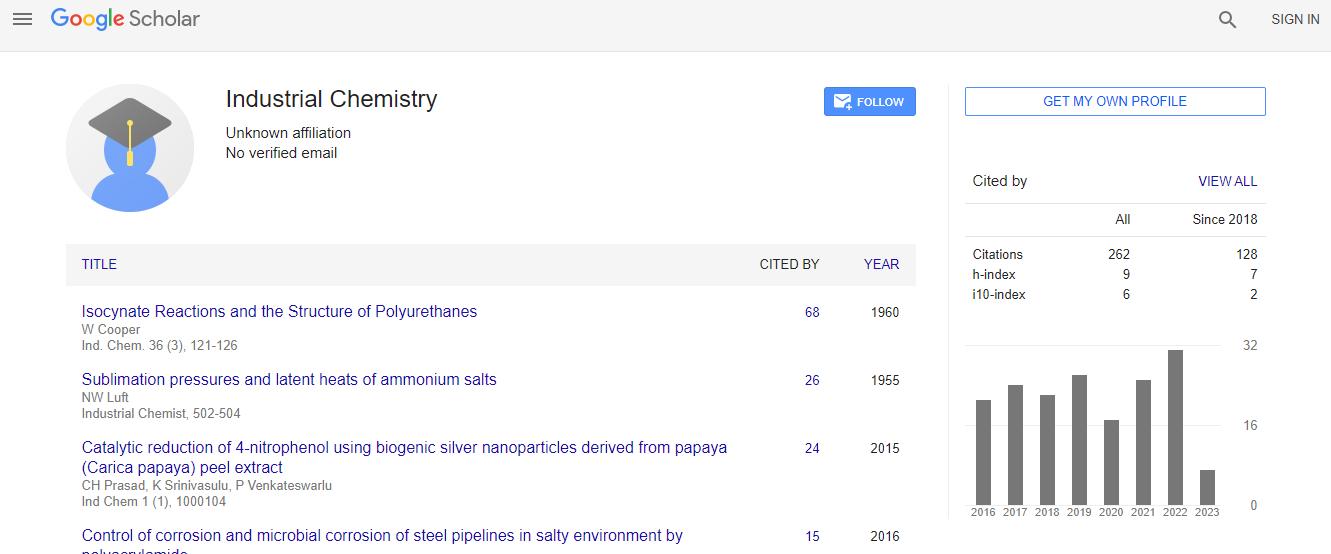Our Group organises 3000+ Global Conferenceseries Events every year across USA, Europe & Asia with support from 1000 more scientific Societies and Publishes 700+ Open Access Journals which contains over 50000 eminent personalities, reputed scientists as editorial board members.
Open Access Journals gaining more Readers and Citations
700 Journals and 15,000,000 Readers Each Journal is getting 25,000+ Readers
Google Scholar citation report
Citations : 262
Industrial Chemistry received 262 citations as per Google Scholar report
Indexed In
- Index Copernicus
- Google Scholar
- RefSeek
- Directory of Research Journal Indexing (DRJI)
- Hamdard University
- EBSCO A-Z
- OCLC- WorldCat
- Scholarsteer
- Geneva Foundation for Medical Education and Research
- Euro Pub
Useful Links
Recommended Journals
Related Subjects
Share This Page
Catalytic water purification driven by solar energy: Fundamental understanding and novel materials
17th International Conference on Industrial Chemistry and Water Treatment
Junwang Tang
University College London, UK
Keynote: Ind Chem
Abstract
Catalytic decontamination of water by solar energy has attracted substantial interest over the past decades. However, to develop an efficient photocatalyst for such environmental purification, in particular water treatment still remains a big challenge, involving Material Science, Chemistry, Engineering and Physics. In particular, there is not a cost-effective way to deal with large volume of water contaminated by small amount of organic substance or extreme large amount of contaminated water in suburban region (e.g. oil spill in Mexico Gulf, in China Bohai Sea). Inorganic photocatalysis using solar energy to mineralize organic contaminants in principal is the potentially best solution to these issues and works in the cost-effective way. Recently, we preliminarily illustrated the key factors dominating the efficiency of process driven by light irradiation. Following that, water treatment was carried out in my group which is a challenging topic due to its complexity. In this talk, the mechanism of the chemical process, involving charge transfer and reaction with oxygen, will be addressed and structured/junction material development will be presented, resulting into a few times higher activity for textile water treatment and simulated river water treatment compared with the benchmark photocatalyst P25. Furthermore, a new and facile method to synthesize these active photocatalysts will be discussed.Biography
Junwang Tang is the Director of UCL Materials Hub, Professor of Chemistry and Materials Engineering in the Department of Chemical Engineering, and a Fellow of the RSC. He has received his PhD in Physical Chemistry in 2001. After taking a JSPS Fellowship in Japan he became Senior Researcher in Imperial College London. Later, he has joined the Department of Chemical Engineering at University College London to take a Permanent Faculty position. He currently leads a research team including postdoctoral researchers, academic visitors and research students with financial support from UK EPSRC, Leverhulme, Royal Society, Royal Academy of Engineering, Newton Fund, EU PF7, Qatar and so on.
Email:junwang.tang@ucl.ac.uk

 Spanish
Spanish  Chinese
Chinese  Russian
Russian  German
German  French
French  Japanese
Japanese  Portuguese
Portuguese  Hindi
Hindi 